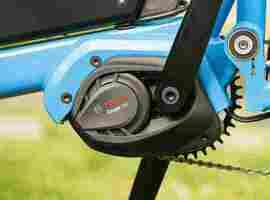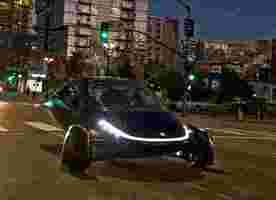United dragged by Twitter over greenwashing with its ‘100% sustainable fuel’ flight
Wednesday was a “historic” day for aviation, United Airlines claims .

Boeing 737 MAX 8 flew from Chicago’s O’Hare International Airport and headed to Reagan National Airport in Washington, DC, marking the “world’s first passenger flight using 100% sustainable aviation fuel (SAF).”
At first glance, the statement seems very impressive, but a closer look reveals that it might be an exaggeration. And yes, the Twitterverse has something to say about United’s greenwashing technique.
We’ll turn to Twitter’s snarky comments soon, but first things first: What’s this sustainable aviation fuel (SAF) United is boasting about?
SAF is a clean substitute for fossil jet fuels. Rather than being refined from petroleum, SAF is produced from sustainable feedstock such as cooking oil, solid waste from homes, and even food scraps.
This 2-minute explainer video from the International Air Transport Association (IATA) lays out everything you need to know much better than I ever could:
So SAF is indeed a sustainable alternative and has the potential to cut down 80% of CO2 emissions produced by conventional jet fuel.
Then why Twitter is attacking United Airlines for greenwashing?
And it’s clear enough if you read the press release , as some of Twitter’s users did.
In fact, one engine was running with 100% SAF and the other with traditional jet fuel.
That’s because the US Federal Aviation Administration (FAA) allows for a 50% total of SAT to be used during a flight, United explains.
For this reason, SAF is basically employed by airlines as a drop-in fuel that gets blended with the conventional one at a 50-50 ratio. United decided to fly its plane with one SAT-powered engine and one fossil fuel-powered to demonstrate that “there are no operational differences between the two.”
That’s definitely an admirable experiment, but Twitter folks are right to call United’s statement misleading, even if they’re not in the aviation industry.
Naturally, many Twitter users asked not only how SAF is made, but also how sustainable it really is. One wondered, “What is sustainable fuel for planes? Curious…”
Indeed, SAF focuses on this type of feedstock to make its lifecycle as green as possible. However according to IATA , “there are emissions produced during the production of SAF, from the equipment needed to grow the crop, transport the raw goods, refine the fuel and so on.”
But when Twitter user Michael Polanyi, Policy and Campaign Manager at Nature Canada , asked about the greenhouse emissions involved in the production of SAFs, United offered no reply.
Actually, that’s the comment I would have posted on Twitter.
United’s flight is meant to demonstrate the “scalable uses of SAF by all airlines in the future”, but that’s easier said than done.
According to IATA , current volumes of SAF represent less than 1% of the total jet fuel demand. And scaling up the volume is actually a very big challenge.
A recent paper by the International Council on Transportation (ICCT) has focused on the EU to estimate SAF feedstock availability to meet the growing aviation demand.
Here are two alarming conclusions:
And that’s for the EU alone. I don’t even want to imagine the numbers if the same study was applied to the US.
Besides the production challenges, there’s one more important factor to consider: the elevated cost of SAF. According to IHS Markit , SAF prices are about five times higher than prices for conventional jet fuel.
So what does that mean for us, the customers? That’s right: higher prices.
Either way, I’m actually in favor of SAF and support any green initiative aiming to help us tackle climate change. But the truth is that alternatives such as SAF are like using a bandage for a wound that requires stitches.
I believe the following tweet perfectly summarizes the situation and gives us some food for though. I don’t know who Timlagor is but they make an interesting point:
Your ebike doesn’t need a ton of power to be worth the price
Whenever I read a review of a lightweight ebike, inevitably someone in the comments feels the need to point out: “you can get the Powertron Cyclenator with a 1,000,000W motor for this kind of money!” Or, you know, something like that.

I’ll admit, when I first started to ride and review ebikes, I thought much the same. I’m a big guy, after all, and back then I had pretty much no cycling experience beyond just knowing how to ride a bike. More power for the money always seemed like a good idea. How else was I going to get up that one nasty hill?
But after reviewing a couple of years of testing ebikes one thing has become obvious: the power specs tell you little about a bike’s performance. They tell you even less about how much you might actually enjoy riding and living with a bike.
Let me make one thing clear: This article isn’t meant to disparage high-powered ebikes or even dissuade anyone from buying a high-powered ebike — they can be a blast, and you should ride whatever you want. If you’ve already tried out several ebikes, chances are you know what you want. I’m not here to judge you.
Instead, I’m aiming this at ebike newcomers. It’s my experience that many people buying their first ebikes aren’t used to riding a bike at all, so it’s easy to assume more power is automatically better.
This isn’t always the case.
The most common spec people will look at is an ebike’s power or wattage rating — perhaps because it’s one of the most prominent in marketing. You’ll see many ebikes rated at 750W in the US, for example, and some that claim even higher performance. Yet most of the ebikes sold in Europe are limited to 250W. Does that mean that European ebikes are all weaksauce?
Hardly.
While an ebike might be nominally rated at 250W, this is usually given as a ‘continuous’ or sustained power rating; this is essentially how much power the motor is allowed to produce over a very extended period of time. However, the majority of these motors are capable of providing temporary assistance that goes far beyond the 250W rating; it is not uncommon for them to deliver twice that power output — or more — during a climb, for example. (For a more technical explanation of how this is possible, ebikeschoolom has a good writeup here .)
In my experience, this means a motor’s watt rating is a very poor predictor of the amount of assist a bike appears to be providing, especially when comparing across different types of motors. Sure, the 750W hub motors I’ve ridden generally feel faster than the 250W hub motors (not always!), but things get a lot fuzzier in smaller increments (say, a 350W motor vs a 500W motor).
It’s also a lot more complicated when comparing a hub drive to a mid-drive , which even at 250W often provide a ton of assistance (mid-drives are also more efficient because they can leverage your bike’s gears).
That said, some ebike companies do provide a ‘peak’ power rating, which should give you a better idea of what to expect, although it’s not definitive.
A much more useful figure is the motor’s torque rating, which tends to correlate more with the feeling of having ‘super legs.’ You especially appreciate the extra torque when going up a hill, carrying cargo, or starting from a stop.
For example, the vast majority of mid-drives from the bigger, more reputable brands (Shimano, Bosch, Yamaha, Brose, etc) are all rated at 250W, but they typically differentiate their product tiers by torque rating. A cheaper mid-drive might only deliver 30-50 Newton-meters of torque, while heavy-duty motors meant for mountain biking and cargo will tend to pull 60-90 Nm.


This all gets further muddled by the lack of global standards around how ebike watts and torque are measured. Any manufacturer can claim 200 Nm of torque, but there isn’t an easy way to verify it. Likewise, the specific implementation of the motors can dramatically, with some opting for a gentle acceleration curve, and others giving you a big boost of speed from the getgo. On some bikes, these curves are even customizable.
Torque and power ratings are most useful when comparing units of the same category within the same motor brand, but beyond that, they should only be used as a rough guide. A bike’s geometry and drivetrain can affect the feeling of assistance as well.
Case in point: my current ebike of choice is the Brompton Electric , a small folding bike with a ‘measly’ 250W front hub motor limited to 15 mph. Despite the seemingly weaksauce motor, it has some of the zippiest acceleration I’ve seen on an ebike — no doubt aided by its small wheels — and is one of the ones that least struggles to get me up a hill.
But let’s imagine that specifications weren’t so unreliable. Do you actually want all that power?
If you’re new to ebikes, you might not know how much power you actually need. And there’s no question that if you live in a very hilly area, have joint problems, and/or have other health issues, opting for something with more assistance can certainly be the smarter choice. Maybe you want an ebike purely to get you from point A to B as quickly as possible. Perhaps you rely on your bike for your job. Or maybe you’re just a speed demon. That’s all fine.
But if that doesn’t quite sound like you, you shouldn’t just dismiss low-power ebikes out of hand. They can have many advantages of their own.
The most obvious of these is weight: Powerful motors are often bigger, and will tend to require a bigger battery to provide a given amount of range. It’s rare to find a 750W ebike under 50 pounds, for example, and many, if not most, weigh over 60 lbs. This might not be an issue if you live somewhere where you never have to lift your bike, but if you live in a city and/or a small apartment, this can get real old, real fast.
While not all ebikes with weaker motors are light, they’re certainly more likely to be. Some potential advantages of these types of ebikes include:
They feel more like riding a regular bike.
It’ll be easier to bring the bike up a flight of stairs onto a train.
You might be able to hang it on a wall or mount it on a car rack more easily.
In my experience, a bike shop is much more likely to flat out tell you “we don’t work on ebikes” when it’s a big and heavy bike. They just don’t want to deal with it.
If you opt for a ‘stealth’ ebike like the Ride1Up Roadster V2 , it might be less appealing to thieves than something with an obvious battery.
You’ll get fewer side-eyes from cyclists on non-electric bikes.
They’re easier to pedal when the battery runs out, which will happen to you sooner or later. Trust me, it sucks to be stuck with a 70-pound bike with no battery left.
These bikes tend to be cheaper.
Replacement or backup batteries tend to be smaller, and therefore cheaper as well.
If you’re altogether new to cycling, you might overestimate how much power you really need or even want. I’m not a complete couch potato, yet when I started riding ebikes, I’d apparently forgotten that people of all sizes have been getting around on ‘acoustic’ bikes just fine for decades.
The more I tested ebikes, the more I found I gravitated towards those that felt the most natural to ride and easiest to live with — not those with the most powerful motors and biggest batteries. Sure, it’s still fun to zip around at 28mph with minimal effort. But for most of my day-to-day riding, a bike that simply helps me get up hills and accelerate quickly without sweating too much is all I really want.
Of course, my experiences may not reflect your own, but my point is that having more power isn’t going to guarantee a better ride. These days, power and speed numbers barely factor into what I choose to ride next. Instead, I look at more subtle details that are less likely to show up in ads and marketing materials:
How much does the bike weigh?
What’s the drivetrain like?
How good are the brakes?
How easy is the bike to service?
Does the bike use a bunch of proprietary parts?
Does the bike try to minimize maintenance?
What’s customer service like?
Can you test ride it at a local dealership?
Will the company still support the bike 5 years from now?
Are replacement parts available?
Does it deter thieves via a stealthy design or built-in security
Is it a mid-drive or hub drive ?
Does it have a torque sensor or just an inferior cadence sensor?
What’s the acceleration curve like?
Does the bike offer removable batteries or range extenders?
Does it feel good to ride?
As much as I’d love to be able to read a bike’s motor specs and determine if it’s any good, there’s a lot more to an ebike than what you can gather from a few simple numbers.
Of course, you can’t test-ride most of the ebikes out there, especially if you don’t live in a major city, but you might be able to find something with a similar motor system. You could try to find a bike with a similar power and torque rating to see how much power you consider ‘enough.’
If that’s not feasible, I suggest looking up user impressions on the bike or even specific components. You may find you don’t need all that much power after all.
Is it a car? Is it a motorbike? No, it’s an autocycle!
You might have seen a weird vehicle at any number of recent car show that sits somewhere between motorcycles and cars.

It’s called an autocycle, and while the idea is hardly new, it kind of reached its peak about 2014, only to leave most hopeful buyers cooling their heels waiting for vehicles to roll off the factory floor.
But what is an autocycle? Where does it sit in the mobility ecosystem? More importantly, can it emerge as the future of micromobility?
What is an autocycle?


Legally, an autocycle is a three-wheeled, typically enclosed vehicle, that, as the name suggests, is essentially part motorcycle and part car.
Let’s compare it to a three-wheel motorbike:
According to the National Conference of State Legislatures (NCSL) there are several key three-wheel motorcycle characteristics
It has handlebars
You can straddle or sit astride
Need to be registered as a motorbike
The driver must wear a helmet
By comparison, autocycles are defined by a number of key characteristics:
Usually has a steering wheel
Usually, the driver sits in a seat
Vehicle may include side passenger or back seat
May need a driver’s license AND motorcycle license
The driver may have to wear a helmet (varies per US state)
In Europe, autocycles fall under Category L , including vehicles like powered cycles, two- and three-wheel mopeds, two- and three-wheel motorcycles, and motorcycles with side-cars.
In the US, things get more complicated, with requirements and regulations varying state by state. Most of these haven’t changed since 2017, but have become a priority in states where companies are building autocycles or looking to roll them out commercially.
What are the advantages of an autocycle?
Affordability: autocycles are far cheaper than most cars.
Less compliance with safety standards means greater freedom for designers.
Lower carbon footprint as most of today’s autocycles are EVs. The three wheels reduce the number of friction points coming in contact with the road, which increases energy efficiency.
A lower center of gravity and forward-weighted body increases stability compared to two-wheel vehicles.
The opportunity to be an early adopter in a new mode of transport.
Fun and novelty factor! People will notice you in one of these.
What are the disadvantages of an autocycle?
Lower safety standards than cars can mean no airbags, roll cages, or even safety belts.
While you can place orders with several manufacturers, there are few models on the road today.
While the vehicles are smaller than typical autos, you can only use them on the road, so they don’t reduce traffic.
Low passenger capabilities mean more vehicles on the road.
Their use is limited mainly to urban areas.
Their low market traction may make it hard to find an appropriate vehicle insurer.
What can I buy?
There are not all that many autocycles that you can buy. Most have been in production for well over five years without releasing a commercial autocycle, while some companies like Polaris have already brought other vehicles to market.
During the time of manufacturing, most have pivoted from gas-powered to electric vehicles.
Elio Motors
Perhaps the most well-known autocycle brand is Elio Motors. The company raised a staggering $16 million in crowdfunding in 2015, promising vehicles for a mere $6,800. Then, it was years of radio silence, with plenty of people wondering if they were scammed and would ever see a vehicle in their garage.
If I ordered a car in 2013 only to have production pushed back again and again with very little communication, I’d be worried.
Well, after years of radio silence, in September, the brand announced a pivot to an electric version of their three-wheeled vehicle.
The Elio-E is priced at $14,900, considerably higher than the original cost. It promises a range of 240 kilometers (150 miles) with a top speed over 160 kmph (100 mph) — where you could ride at that speed, is anyone’s guess.
Safety-wise, the Elio comes with three airbags, an anti-lock braking system, and electronic stability control.
But will they ever go to market?!
Aptera
While Aptera started in 2008, they’ve yet to produce a car commercially. It has, however, created three different prototypes. The company has a long history in solar vehicle development, even going bankrupt due to a lack of investment in the early 2000s.
However, the company found new traction by announcing its efforts to create a solar electric vehicle in 2019. Its vehicles aim to handle most daily driving needs completely off the grid.
Over the last year, Aptera released two alpha prototypes of its solar electric vehicle, most recently releasing a third ready for beta testing called Luna.
It offers 700 watts of continuous charging power and a 1000 mile range thanks to assistance from its diamond-shaped solar panels.
Luna seats two people and runs on all-wheel-drive with vectorized torque control making the autocycle suitable for snow, ice, sand, and gravel terrains.
Prices start at $25,900.
The company has lofty plans for a series of future vehicles, including autonomous capabilities, 6-passenger cars, 2-seat commuters, and utility vehicles up to 18-wheelers.
Maybe get just one to market first?!
The company has raised $60 million in series A funding and has 10,000 reservations.
Slingshot
The Slingshot electric autocycle looks sporty, which is not surprising considering its heritage. It’s made by Polaris , a brand known for its on and off-road vehicles, snowmobiles, military offerings, and a range of other ways to get you moving on offer.
The company has been around since 1954, so at least you can be guaranteed of its ability to bring vehicles to market,
The Slingshot retails somewhere between $20,000 and $30,000 depending on your design specifications. Somewhat ominous, the company notes in tiny letters on its website:
There are three versions on offer ranging from $20k to $30k, and unlike its contemporaries, they run on an ICE. There’s no cover from the elements, but Slingshot models also come with Ride Command, a 7-inch display that controls Bluetooth and USB audio, navigation, and vehicle info.
Arcimoto
Described by its company as a “Fun Utility Vehicle”, the Arcimoto is an electric vehicle that can achieve an estimated 112 km (70 miles) range at its most basic configuration, or 210 kilometers (130 miles) with an optional range extender.
The company has a lot to say about safety, noting its use of passenger car standards as reference for due care, especially regarding the physical design, seatbelt functionality, and a crash-sensor that supports immediate automatic battery disconnect high-voltage traction power.
The FUV also sports a kinetic energy recovery system (“regenerative braking”) to slow the vehicle’s motion at speed while capturing energy back into the battery and features full windshield wiping and washing systems for visibility.
Unsurprisingly, the makers don’t recommend its use in deep snow or on unplowed roads. The Acrcimoto autocycle is currently available in California, Oregon, Washington, Nevada, Arizona, and Florida.
Can autocycles succeed when microcars failed to scale?
There’s been plenty of efforts to make small, functional city vehicles like microcars . Historic efforts include cars like the Reliant Robin , praised more for its cuteness over functionality. Unfortunately, they were slow, noisy, and prone to flipping.
But there’s a one in the market that might be a serious contender in the small vehicle stakes. The Renault Twizy is a tiny one-person EV priced at €6,990 ($7885). It offers an “urban-cycle range” of 100km thanks to a 6kWh lithium-ion battery and energy recovery under deceleration.
It comes in two versions:
The Twizy 45 has its top speed capped at 45 kmph and drivers only need to be 16 to drive one in France.
Twizy 80 has a top speed of 80kmph and requires users to have a valid B driving license .
Small vehicles (both microcars and autocycles) make sense in cities — they’re energy-efficient, easy to handle, and easy to park.
But the bigger challenge is helping attract owners. It’s a chicken and egg problem, as we won’t see mass adoption until we see them out and about on the streets, and that’s taking a lot longer than I would have hoped.